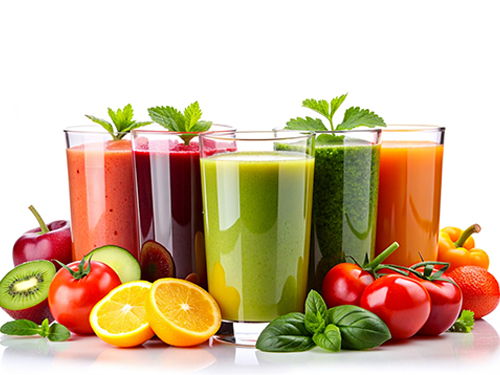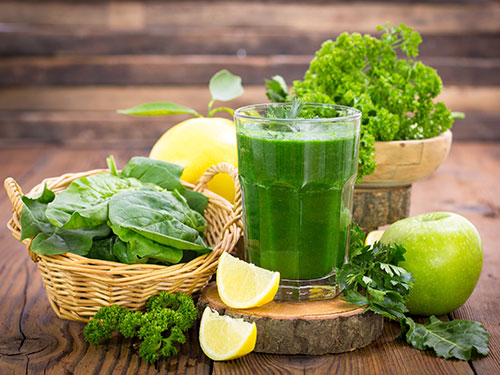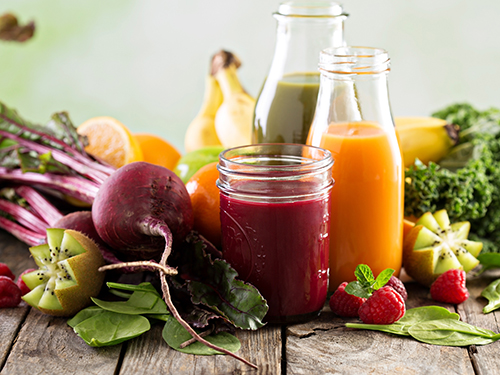
Fact Sheet FS1245

An All-Around Healthy Smoothie
With a busy schedule, it can be challenging to eat all the foods you need to stay healthy. Smoothies can be a great option for a healthy, on-the-go breakfast, snack, or dessert for kids and adults. The ingredients you choose influence the nutrient content of your smoothie. Not all smoothies are a nutritious choice; some are loaded with sugar, fat, and extra calories. A smoothie that includes ingredients like vegetables, fruits, protein foods, and dairy or dairy alternatives is nutrient-rich and packed with vitamins, minerals, fiber, antioxidants, and more.
With a little planning, you can build a nutrient-packed smoothie that is both tasty and healthy. Use MyPlate, the USDA's nutrition guide to help you build a "better" smoothie. Try these tips to incorporate as many of the MyPlate food groups as possible:
Fruits & Vegetables
Most Americans do not eat all the daily recommended fruit and vegetable servings needed for optimal health. Both fruits and vegetables support digestion, help reduce cholesterol, and lower the risk of developing heart disease, cancer, and diabetes. Adding fruits and vegetables to smoothies can be a great way to get the vitamins, minerals, fiber, and antioxidants you need to support many important functions in the body, including immune health, bone strength, and cellular repair.Choose a smoothie recipe that combines both fruits and vegetables. Sweet fruits blend nicely with many vegetables to create a tasty, nutrient-packed smoothie. Vegetables typically have fewer calories than fruits. Calorie for calorie, vegetables add more nutrients and less sugar to a smoothie. Use fruits to enhance the flavor of your smoothie. Rely on vegetables to balance out the flavor and boost the nutrient density of your smoothie. Select recipes that use at least a 1:1 vegetable to fruit ratio, meaning at least equal parts vegetables to fruit.
Protein
There is limited research available to document how the amount of protein you eat impacts the development of chronic diseases. However, evidence is mounting to suggest that high-protein foods may play a role in improving the health of an aging population by improving muscle health, preventing loss of muscle tissue, and aiding in heart function. Adding protein-rich ingredients like beans, seeds, and nuts to your smoothie will increase the potential health benefits of your smoothie. These ingredients will also keep you feeling full for a longer time. Dairy and non-dairy milk options, such as almond milk or soy milk, can also add extra protein to your smoothie. When choosing milk, it is also important to choose fortified milks without any added sugars. For example, look for unsweetened almond milk or soy milk.Dairy
Dairy foods like milk and yogurt are often used to give smoothies a thicker, smoother texture. Dairy foods are packed with calcium, vitamin D, and phosphorus to build strong bones. Selecting reduced fat and fat-free milks and yogurts offers another lower-fat protein ingredient and an excellent source of calcium.Grains
Grains make a delicious addition to a smoothie. Adding whole grains like oatmeal, flaxseeds, and quinoa to a smoothie will thicken the texture and add dietary fiber. Dietary fiber helps you feel fuller for a longer time, while helping your body digest the foods you eat. Dietary fiber can help lower cholesterol, reduce the risk of developing diabetes, and help prevent constipation and diverticulosis.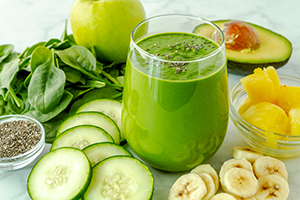
Which Smoothie is Best for Me?
Pick a smoothie recipe that serves the best purpose for your lifestyle. Are you trying to eat more greens or calcium-rich foods? Are you trying to eat more lean protein or include more fiber in your daily meal plan? Or do you need an alternative treat as a dessert replacement or a healthy, "on-the-go" breakfast? If chosen wisely, a smoothie can be a convenient and tasty option to promote a healthy lifestyle. Follow these steps to build a better smoothie.
Step #1 -- Choose A Base!
Bases provide the foundation for a smoothie. When preparing, add the base first, so it sits at the bottom of the blender. This will help blend all ingredients more easily. There are a variety of bases to choose from.
Step # 2 -- Pick a Fruit!
You can use canned, fresh, or frozen fruit in a smoothie. Choose fruits that are canned in their own juice or 100% fruit juice, rather than syrups. If you use frozen fruit, be sure to use less ice. Larger fresh fruits (peaches, apples, etc.) blend easier if they are peeled and cut, rather than added whole. Bananas are a common smoothie ingredient because they add thickness while adding a mild flavor. Fruits will sweeten a smoothie, while providing antioxidants and color.
Step # 3 -- Add a Vegetable!
Whether you choose spinach for its mild flavor, trendy kale or collard greens, or something unique like parsley or Swiss chard, adding dark green, leafy vegetables will fill your smoothie with vitamins, minerals, antioxidants, and fiber. Chop tougher leaves like kale and collards to help them blend more easily. Freezing leaves improves the blend-ability. Avocados and mashed red/orange vegetables such as pumpkin, sweet potatoes, butternut squash, and carrots add thickness to smoothies. They are also rich in vitamin A and antioxidants like beta-carotene, which help protect against certain types of cancer and other chronic diseases.
Step #4 -- Boost Up the Nutrition!
Once you have added ingredients from each of the food groups, try adding a "booster" to enhance the flavor. Add walnuts or almonds for a boost of protein. For a treat, add unsweetened cocoa powder or cinnamon. Flax and chia seeds provide Omega-3 fatty acids for heart health. Adding these healthy boosters will provide a great flavor while keeping you fuller longer. Blend in mashed beans (black, red, white, kidney and navy) for a protein and fiber boost. Beans thicken smoothies without adding flavor, and they blend well.
Smoothies can be a convenient and nutritious option for tasty breakfast, snack or dessert that provides vitamins, minerals, and protein. Give some of our favorite recipes a try; then, experiment by using our smoothie chart as a guide. There is no limit to what you can create.
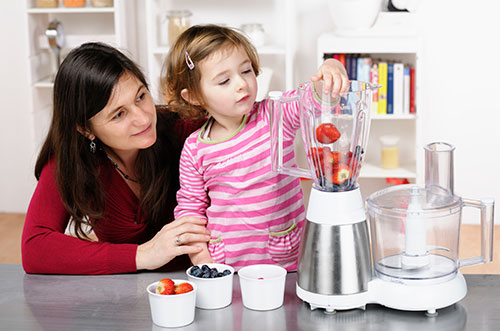
For More Information
Family and Community Health Sciences (FCHS) works with families, schools, and communities to promote healthy eating and healthy lifestyles. Visit njaes.rutgers.edu/fchs for information on all our programs, and learn how to bring them to your school, worksite, or community organization.
Build Your Smoothie Recipe Collection with these Favorite Smoothie Recipes
Cool Tropical Smoothie
Recipe adapted from HealthEssentials.
Pumpkin Smoothie
Recipe from SNAP4CT
High-Protein Blueberry Smoothie
This smoothie will be a favorite! It's a great breakfast smoothie that will keep you full throughout the day. The added cottage cheese does the trick and increases protein while the blueberries and spinach/kale add key vitamins, minerals, and phytonutrients to support health.
Recipe by Yara Helmy, MS, RDN
Superfood Smoothie
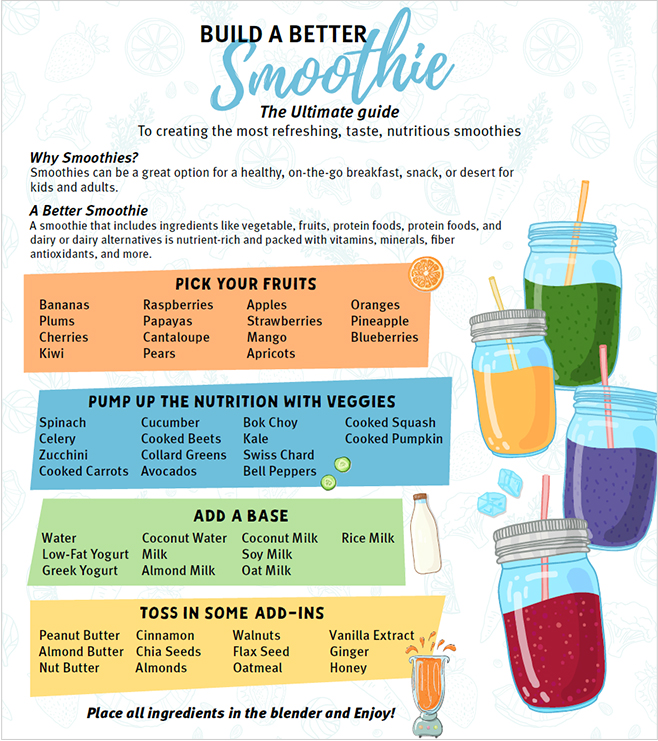
May 2024
Copyright © 2024 Rutgers, The State University of New Jersey. All rights reserved.
For more information: njaes.rutgers.edu.
Cooperating Agencies: Rutgers, The State University of New Jersey, U.S. Department of Agriculture, and Boards of County Commissioners. Rutgers Cooperative Extension, a unit of the Rutgers New Jersey Agricultural Experiment Station, is an equal opportunity program provider and employer.


